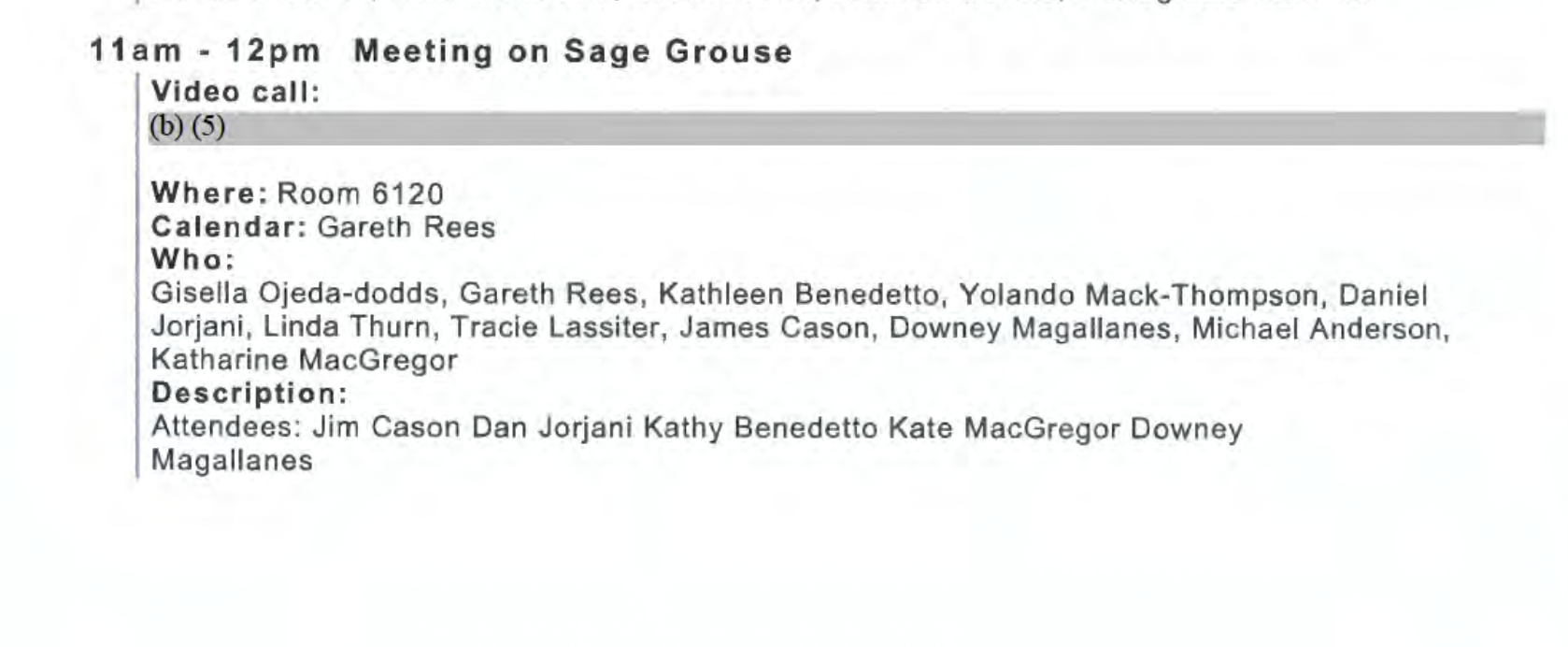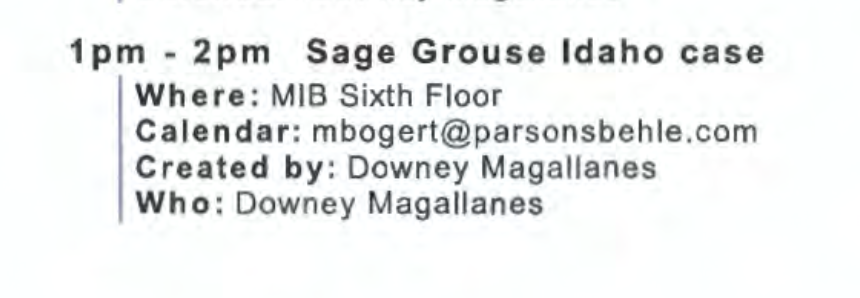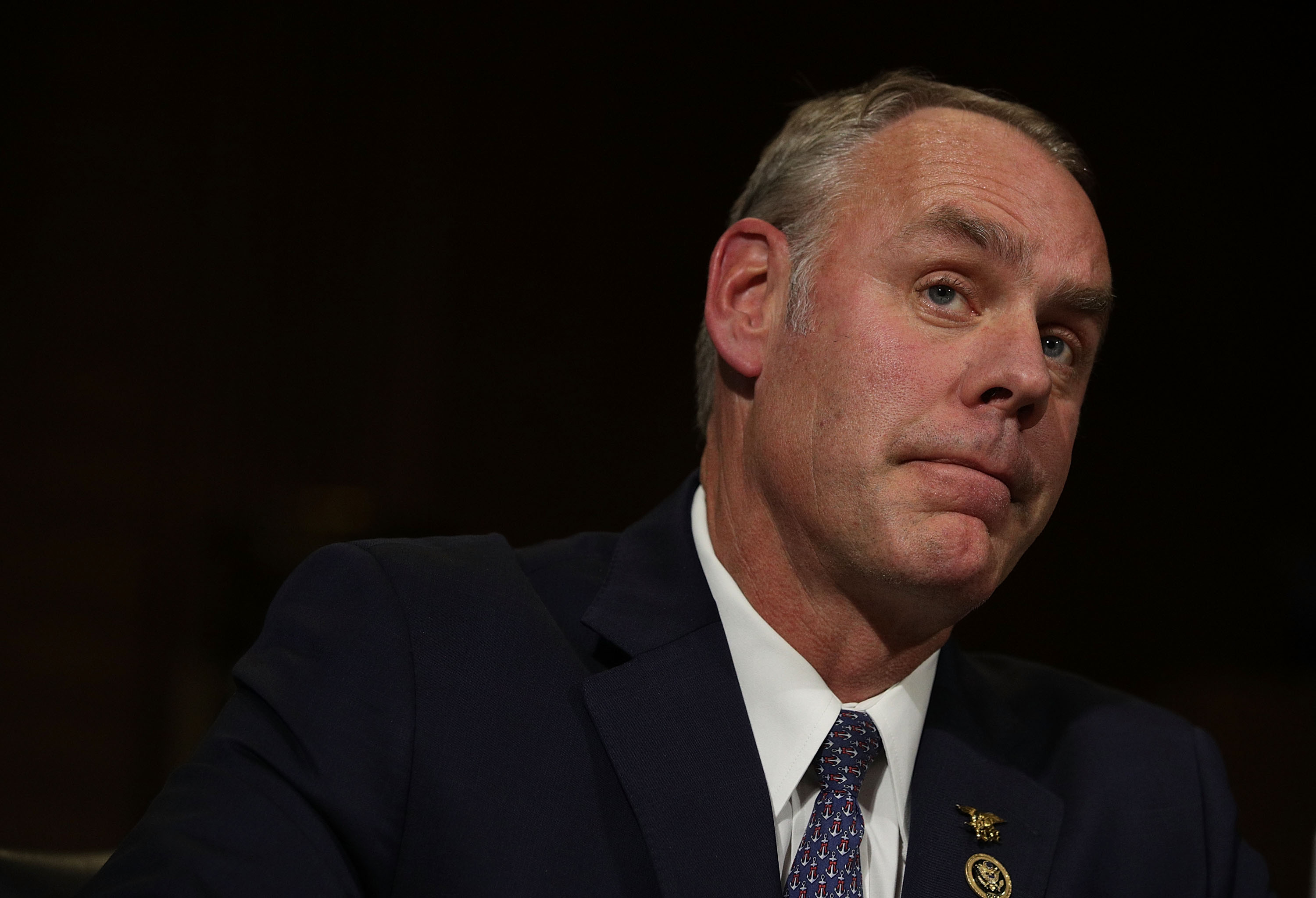Though in power for little more than a year, Secretary of the Interior Ryan Zinke has already exhibited a near-total deference to the needs and desires of industry lobbyists and conservative activists. Whether shrinking national monuments, ending the federal land coal-mining moratorium, or rolling back Obama-era wilderness protections, evidence abounds that Zinke and his leadership team are pursuing a policy agenda that directly benefits wealthy GOP donors, powerful special interest organizations, and their allies in state government. More evidence, meanwhile, emerges every day.
Consider the saga of the greater sage grouse, the chicken-like bird that kicked off an impassioned political struggle in the American West in recent years. The sage grouse is a skittish steppe-dwelling species that has seen its populations plummet in recent decades as oil and gas drillers, real estate developers, mining firms, transmission lines, wildfire, disease, and other anthropogenic threats have overtaken its range. In the 11 Western states where the species resides, grouse populations have declined by 30 percent since 1985 alone. The grouse, meanwhile, is an indicator species: Its decline is a sign that sagebrush habitat and the hundreds of other species that depend on it are in decline too. As a result, conservationists, scientists, and more have pressed to protect the bird at the landscape level in order to prevent it and other species from sliding toward extinction. In 2015, the Obama administration responded to their calls and adopted a series of unprecedented grouse conservation plans on federal lands across the West. Though hardly perfect, the plans are meant to keep the species alive.
Since the Trump administration took office in 2017, however, the Department of the Interior (DOI) has done everything in its power to shred the conservation plans that the previous administration put in place. It has opened up grouse habitat to renewed oil and gas drilling. It has canceled an initiative to restrict hard-rock mining on key sagebrush landscapes. And it has begun reviewing and revising the plans outright with the explicit aim of making the regulations less burdensome on energy developers. All the while, top DOI officials have been meeting consistently with industry groups, lawyers, and lobbyists deeply opposed to federal sage grouse protection.
A review of public records—some released weeks or months ago, others newly obtained by Pacific Standard—shed light on the industry insiders and revolving-door lobbyists and lawyers who have been influencing DOI’s actions on sage grouse policy. These records suggest that the Department of the Interior is in thrall to private enterprise and conservative political factions at the expense of the public interest—and the imperiled bird’s future.

In 2015, after a pressure campaign by oil and gas interests and conservative politicians, the Obama administration decided not to list the greater sage grouse under the Endangered Species Act. Instead, the administration opted for a more congenial approach. It gathered input from an array of interested parties—including Western state governments, industry groups, ranchers, scientists, and conservationists—and crafted a series of land use plans that would protect sage grouse habitat on federal holdings across the West. Among other things, this vast landscape-scale effort limited the type and quantity of industrial disturbance in key grouse breeding grounds. It also aimed to prohibit future mining operations on 10 million acres of grouse habitat.
Since their inception, these sage grouse conservation plans have had both staunch supporters and ardent detractors. Many organizations and individuals, including numerous environmental and wildlife groups as well as multiple Western governors, have defended the plans as a new model for collaborative conservation. Others, however, were not so happy.
MEET THE FORMER KOCH ADVISER SLASHING CONSERVATION SAFEGUARDS AT THE DEPARTMENT OF THE INTERIOR: Daniel Jorjani, the Department of the Interior’s principal deputy solicitor, once advised Charles Koch. Now, he takes meetings with industry representatives and rolls back conservation protections.
After the Obama administration unveiled the plans, a flood of lawsuits ensued. Environmental non-profits like WildEarth Guardians and the Western Watersheds Project sued because they said the plans did not go far enough to protect the species as required under law. Multiple industry groups and conservative state governments, including Idaho, Utah, and the Western Energy Alliance, filed their own challenges, arguing that the Obama administration’s plans were nearly as restrictive as an Endangered Species Act listing and ultimately illegal.
The state of Idaho, helmed by its ultra-conservative governor, Butch Otter, was among the first to challenge the plans in court. It filed a federal lawsuit in September of 2015 contending that the Obama administration’s sage grouse plans had ignored Idaho’s input on the matter. In early January of 2017, just a few weeks before the Trump administration took power, Idaho suffered a legal setback when a federal judge dismissed its suit, saying that the state lacked standing because it didn’t prove that it had been harmed by the plans. Otter, who has taken more than $200,000 in campaign cash from the oil and gas and mining industries over the course of his career, appealed the decision.
Even though the governor’s lawsuit was on shaky ground, his lawyers were also at work on the inside track. Indeed, they had access to high-level political appointees in the DOI, and they made use of it.
By late January of 2017, less than a month after Idaho’s case was dismissed in federal court, one of the state’s lawyers, Thomas Perry, began collaborating with top DOI brass. Perry formerly served as the chief legal advisor to Otter of Idaho and is a partner at Marten Law, an Idaho-based firm that is representing the state government in its sage grouse suit. According to his LinkedIn page, he was formerly employed by the National Mining Association as well.
Perry teamed up with Michael Bogert, a revolving door lawyer and mining industry lobbyist who served in George W. Bush’s Department of the Interior as a counselor to Secretary Dirk Kempthorne. Bogert now works for the firm Parsons Behle & Latimer, which represents the state of Utah in its sage grouse lawsuit.
According to records obtained through a Freedom of Information Act request, Bogert and Perry together contacted James Schindler, a former legal associate at the Koch-backed Cato Institute and now a special assistant and political operative at DOI.
“James: I am writing to see if Tom Perry and I can place a call to you tomorrow … before noon MST, 2 P EST, to follow up on our visit with you on January 31,” wrote Bogert in a February 15th email on which Perry was copied. “It is in regard to a formal communication by our clients regarding that matter.” Apparently, “that matter” meant sage grouse.

Bogert followed that initial February 15th email with a second email on February 16th, which he sent to James Schindler as well as numerous officials in the Department of Justice. The follow-up email contained a formal letter from Otter as well as Utah Governor Gary Herbert, asking that the Department of Justice agree to willingly suspend the sage grouse lawsuits “in an effort to facilitate … consideration of the United States’ ongoing interest in pursuing or continuing to defend the legal position of the previous Administration.”
Within days, James Schindler replied to Bogert and Perry, telling them that he had read their letter and that he had passed along their request to Downey Magallanes, a deputy chief of staff at DOI and the daughter of a former executive at the coal giant Peabody Energy. As her personal work calendar shows, Magallanes was consistently involved in the development of Zinke’s policy on sage grouse. She attended regular meetings with other top DOI officials on the topic over the course of the Trump administration’s first eight months in office.

During this same period, Magallanes began meeting and speaking with Bogert and Perry, both of whom represent interests staunchly opposed to federal sage grouse protection. According to her calendar, Magallanes first spoke with Bogert and Perry for 30 minutes over the phone on February 22nd, 2017. She had a second call with them on March 6th. She had yet another call with the anti-sage-grouse lawyers on March 14th, one day after she attended a meeting on sage grouse with other high-level political officials like James Cason, Daniel Jorjani, Katharine MacGregor, and Kathy Benedetto. Finally, on March 28th, she had an hour-long meeting with Michael Bogert to discuss the “sage grouse Idaho case.”

Meanwhile, lawyers for The Wilderness Society, which had joined both the Idaho and Utah lawsuits as an intervenor-defendant, were not offered the opportunity to participate in talks with high-level DOI personnel. Unlike Bogert and Perry, The Wilderness Society’s attorneys did not have any calls or meetings with Magallanes or any other top DOI official during this time.
“We were sending letters asking about [the lawsuits] and not getting these conversations,” says Nada Culver, senior counsel at The Wilderness Society. “Nobody has asked us in to talk about our defense of the plans, let me just say that.”

Bogert and Perry, who failed to reply to multiple requests for comment, are not the only anti-sage-grouse operatives who showed up at the Department of the Interior over the last year. Here are a few other prominent examples:
- On April 4th, DOI bigwigs, including Associate Deputy Secretary James Cason, Deputy Assistant Secretary Katharine MacGregor, and Magallanes, attended a 45-minute meeting with the National Mining Association, or NMA. The Association has been a staunch opponent of the federal sage grouse conservation plans, particularly the Obama administration’s proposal to withdraw millions of acres of grouse habitat from future mining claims. One of the NMA’s members, the American Exploration and Mining Association, also sued in federal court to overturn the plans. In 2016 alone, the National Mining Association donated more than $200,000 to Republican Party politicians at the federal level.
- On April 25th, Secretary Zinke, Magallanes, and MacGregor, among others, met with the Western Energy Alliance. WEA has also vociferously opposed federal sage grouse conservation. It filed a lawsuit against the plans in 2016 and was centrally involved in the pressure campaign to prevent the Obama administration from listing the bird under the Endangered Species Act. WEA members like Anadarko, Devon, and Halliburton have given millions of dollars in campaign contributions to the Republican Party and its candidates over the last decade.
- On May 3rd, DOI officials like MacGregor, Magallanes, and Kathleen Benedetto, among others, met with the Women’s Mining Coalition. (Benedetto, it’s worth pointing out, was a co-founder of the Women’s Mining Coalition.) According to public records, one of the topics of the May 3rd meeting was “land use restrictions and prohibitions in the Sage Grouse Lands Use Plan Amendments.”
All of these meetings, all of these various industry groups, lawyers, and lobbyists, seem to have made an impact. On June 7th, Zinke announced that the DOI would officially “review” the Obama-era federal sage grouse plans—plans which cost tens of millions of public dollars and many years to develop.
Zinke created a review team, co-chaired by Benedetto, presently a senior adviser at the Bureau of Land Management. Among other aims, the team was tasked with identifying aspects of the sage grouse plans that could be revised in order to “give appropriate weight to the value of energy and other development of public lands….”
To justify his review of the sage grouse plans, Zinke specifically citied complaints from several Western governors. The most vociferous of these complaints, of course, came from states like Utah and Idaho.

(Photo: Alex Wong/Getty Images)
Mark Salvo, a sage grouse policy expert and the vice president for landscape conservation at Defenders of Wildlife, believes the Utah and Idaho lawsuits may have been used as political cover for the Trump administration’s assault on the sage grouse plans.
“We would argue that the issues raised by some Western states would probably not have won in federal court,” he says, “and so the ongoing lawsuits might have been nothing more than an excuse for the Bureau of Land Management and the Forest Service, directed by the Trump administration, to revise the current sage grouse conservation strategy.”
In fact, not long after Zinke’s announcement, the states of Idaho and Utah got their way and successfully suspended their lawsuits. On June 30th, the DOI and Idaho submitted a joint motion in federal court to stay the state’s case against the sage grouse plans. They justified their action by pointing to the new administration’s review. The DOI and Idaho agreed that the “review of the challenged [sage grouse plans] may result in further administrative action that could obviate the need for litigation in the case.” In other words, DOI policymakers were preparing to do for Idaho what it had failed to do for itself in court—they were preparing to undermine the federal sage grouse plans. On July 13th, 2017, Utah’s case against the federal sage grouse plans was also stayed.
Industry agitation against the sage grouse plans, meanwhile, continued apace. In mid-July of 2017, the Western Energy Alliance sent a letter to Zinke’s sage grouse review team listing the changes that the WEA hoped to see. As the Western Values Project has shown, many of these proposed changes made it into the review team’s final August of 2017 report on possible and proposed modifications to the sage grouse plans. Indeed, the final August report recommended that the Department begin investigating ways to effectively weaken federal protections for the imperiled bird.
In the months that followed, Zinke’s DOI put those recommendations into action and began to dismantle federal sage grouse conservation. In October of 2017, the Department issued a notice in the federal register declaring its intent to potentially amend the greater sage grouse conservation plans. It also overturned the Obama-era initiative to prohibit mineral development on 10 million acres of grouse habitat in the West. Late last year, Zinke’s Bureau of Land Management officially made it easier for oil and gas concerns to drill in crucial grouse habitat. And more is still to come.
“They are tearing down the national greater sage grouse planning strategy. They are wasting years of effort and $45 million of public money that were spent to create this balanced collaborative approach,” says Mark Salvo of Defenders of Wildlife. “And for that matter, they are threatening the future of the sage grouse and other wildlife in sagebrush habitat across the West.”
Heather Swift, the press secretary for the Department of the Interior, did not reply to multiple requests for comment.

Listen to more interviews from Pacific Standard’s podcast, The Edit, here.




